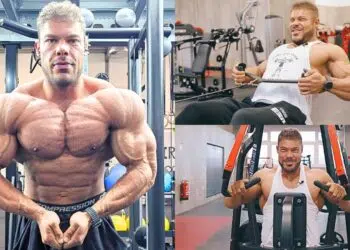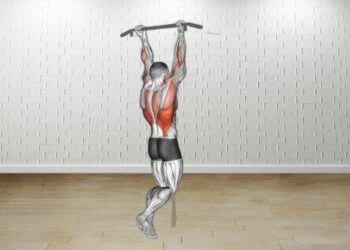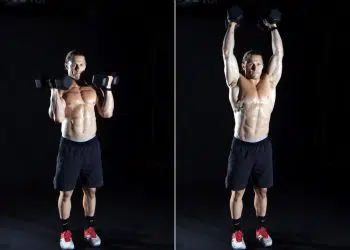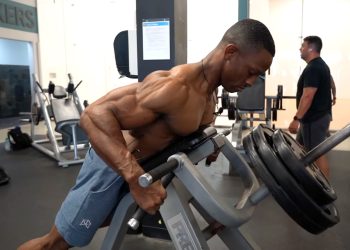The trapezius, also known as the traps, is a large, triangular muscle in the upper back that extends from the skull to the thoracic spine and covers the upper shoulder.
They are an often forgotten piece of the puzzle when it comes to developing a beastly physique and looking good in a tank top. Jacked traps make your shoulders pop even when you are not flexing.
Besides boosting physique aesthetics, traps play several crucial roles, including stabilizing your shoulders, supporting good posture, and helping prevent injuries. Weak traps might also be the reason behind nagging neck pain.
In this article, I’ll share the 10 best trap exercises that have proven their worth in my seven years as a personal trainer. These exercises target the traps from every angle, from the upper to the lower fibers, that are crucial for optimal shoulder health. I’ll also share three trap-focused workouts for building bullet-proof shoulders.
Recent Updates: On May 21, 2024, Fitness Volt’s Senior Editor Vidur Saini revised the list of exercises and added expert tips. We also updated this article to improve readability.
10 Best Trap Exercises For Bigger and Stronger Shoulders
Add the following movements to your arsenal:
Level Up Your Fitness: Join our 💪 strong community in Fitness Volt Newsletter. Get daily inspiration, expert-backed workouts, nutrition tips, the latest in strength sports, and the support you need to reach your goals. Subscribe for free!
1. Barbell Shrugs
| Sets & Reps | 3 x 8-12 |
| Equipment Needed | Barbell, weight plates |
Barbell shrugs primarily bias the upper trapezius, which can help build the coveted mountain-peak traps. It also targets the middle and lower trapezius, levator scapulae, and rhomboids.
“Shrugs are not just about loading the barbell and rushing through as many reps as possible,” says Saini — an ACE-certified personal trainer. “You must pause in the fully shortened position and use slow eccentrics to maximize trap fiber activation.”
How To Perform:
- Stand upright with a hip-width stance.
- Grab a barbell with a shoulder-wide grip against your thighs.
- Brace your core and shrug your shoulders straight up, aiming to touch your ears.
- Pause at the top for one second.
- Use a slow and deliberate motion to return to the starting position.
- Repeat for recommended reps.
Pro Tip: Keep your spine, neck, and head in a neutral position. Dropping your head forward can sprain your neck.
Variations:
- Dumbbell and cable shrugs are effective variations to keep your workouts exciting.
- Beginners should perform this exercise on a Smith machine, as the guided path provides extra stability.
- A clinical trial found that unilateral shrug exercises improved upper trap engagement compared to bilateral variations. (1)
2. Elevated Trap Bar Deadlifts
| Sets & Reps | 3 x 8-12 for hypertrophy, 1-5 for strength |
| Equipment Needed | Trap bar, weight plates, aerobic steppers |
Let’s address the elephant in the room: Yes, you can perform trap bar shrugs, too, but doing the trap bar deads off plyo boxes limits the range of motion (ROM), which can help load the traps and promote hypertrophy.
“Trap bar deadlifts are the best because they allow you to use a wider grip and heavier weights, and it is safer for the shoulders than the barbell shrug,” said Jeff Cavaliere, MS PT CSCS, of the Athlean-X YouTube fame.
The neutral hand position (palms facing each other) in this exercise enhances the range of motion, resulting in greater target muscle activation. This exercise targets the traps and erector spinae muscles, while the glutes, hamstrings, quadriceps, and forearms are the supporting muscles.
How To Perform:
- Position the barbell on elevated blocks so the handles are between shin and knee level. Aim for a height that allows you to keep an upright back in the bottom position.
- Stand inside the trap bar with feet hip-width apart.
- Hinge at the hips and knees and grab the handles with a neutral grip.
- Engage your core and drive through your heels to lift the bar off the floor.
- Pause in the top position.
- Slowly return to the starting position.
Pro Tip: Retract and depress your shoulder blades at the top of your ROM in the fully stretched position for additional trap stimulation.
Variations:
- Make this exercise more challenging by lifting heavier weights without compromising form.
- Increase the block height to limit lower body engagement and load the traps and quads.
3. Farmer’s Carry
| Sets & Reps | 3 x 50 feet |
| Equipment Needed | Dumbbells |
Holding a pair of heavy dumbbells while standing upright is one thing, but walking with them takes the difficulty to a whole new level. The latter stretches your shoulders and traps with each step, delivering a deeper stimulation.
Besides the traps, the farmer’s carry trains the forearms, core, and shoulders.
How To Perform:
- Stand tall while holding a heavy dumbbell in each hand at your sides.
- Retract and depress the scapula.
- Brace your core and take short but steady steps forward.
- Keep your torso as stable as possible, and avoid swinging to the sides.
- Increase the weights and distance as you get stronger.
Pro Tip: This is the exercise where you go as heavy as possible. Avoid heel striking, as it can strain your lower body joints.
Variations:
- Suitcase carries, which involve holding the weight in one hand at a time, are an excellent variation for identifying and ironing out strength and muscle imbalances.
- Use lifting straps if you are prioritizing trap development. Skip them to improve functional strength.
4. Overhead Barbell Carry
| Sets & Reps | 3 x 50 feet |
| Equipment Needed | Barbell, weight plates |
This is a progression exercise to the farmer’s carry. “The overhead barbell carry tests full-body strength and stability, with your traps taking center stage,” remarks Saini. The shoulders and core stabilizers are the other primary muscles, while the forearms and erector spinae muscles take a supporting role.
How To Perform:
- Load a barbell with an appropriate weight in a squat rack.
- Grab the barbell with a slightly wider than shoulder-width grip.
- Brace your core and press the bar overhead to a lockout.
- Extend the shoulder blades for added stability.
- Begin walking with controlled steps while maintaining a tight core.
Pro Tip: Experienced lifters can add to the challenge by performing overhead shrugs after walking the recommended distance.
Variations:
- Dumbbell overhead carries are an excellent alternative for beginners with limited shoulder mobility.
- Unilateral overhead carries can deliver an added core stability challenge.
5. Rack Pulls
| Sets & Reps | 3 x 8-12 for hypertrophy, 1-5 for strength |
| Equipment Needed | Barbell, weight plates, squat rack |
Set the safety pins around hip height, as keeping the torso upright throughout the exercise can lead to greater trap stimulation. Rack pulls target the traps, spinal erectors, glutes, and hamstrings. A lower rack height will also fire up the lats and rhomboids.
Level Up Your Fitness: Join our 💪 strong community in Fitness Volt Newsletter. Get daily inspiration, expert-backed workouts, nutrition tips, the latest in strength sports, and the support you need to reach your goals. Subscribe for free!
How To Perform:
- Pin the safety bars at hip height.
- Assume a hip-width stance, bend your knees, and grab the barbell with a shoulder-wide pronated grip.
- While keeping your back neutral, drive through your heels to extend your knees and stand upright.
- Slowly lower the bar to the starting position.
- Repeat for reps.
Pro Tip: Perform a shrug at the top for greater trap stimulation.
Variations:
- Trap bar rack pulls can lead to greater trapezius muscle engagement.
- Since this exercise involves a limited ROM, use slow eccentrics and concentrics to add to the challenge.
6. Upright Rows
| Sets & Reps | 3 x 8-12 |
| Equipment Needed | Barbell, weight plates |
The upright rows are among the most complicated but effective trap exercises. You must follow a picture-perfect form to fire up the traps while limiting shoulder impingement risk. The deltoids, biceps, and forearms are the secondary muscles in this exercise.
How To Perform:
- Stand erect with a hip-width stance while holding a barbell against your thighs using a shoulder-wide overhand grip.
- While maintaining an upright torso, lift the bar toward your chin by driving your elbows toward the ceiling. Keep the bar as close to your body as possible.
- Your upper arms should be parallel to the floor at the top. Pause in this position for a second.
- Slowly lower to the starting position.
Pro Tip: Focus on developing a mind-muscle connection and contracting the traps with each rep.
Variations:
- Performing this exercise on a cable machine keeps constant tension on the traps throughout the ROM.
- The dumbbell upright tow might be easier on the wrists for some lifters.
7. Face Pulls
| Sets & Reps | 3 x 8-12 |
| Equipment Needed | Cable machine, rope attachment |
“Traps and rear deltoids are the two most neglected muscles in most hypertrophy-focused resistance training routines; the face pulls fix this,” notes Saini.
This exercise also works the rhomboids, rotator cuff muscles, and biceps.
How To Perform:
- Pin the cable pulley at head height and attach a rope handle.
- Grab the ropes with an overhand grip, take a step back, and assume a shoulder-wide stance for optimal stability.
- The cable should be taut in the starting position.
- Initiate the movement by driving your elbows to your sides and behind the midline.
- As you pull, spread the rope apart and focus on contracting the scapula.
- Pause in the fully shortened position.
- Slowly return to the starting position.
Pro Tip: Experiment with your elbow height to find the sweet spot for optimal trap and rear delt stimulation.
Variations:
- Beginners can use a resistance band anchored to a sturdy object. However, it offers a different resistance profile compared to the cable machine. There will be greater tension on the band in the concentric phase compared to the eccentrics.
8. Chest Supported Prone I-Y-T Raises
| Sets & Reps | 3 x 9-12 |
| Equipment Needed | Incline bench, dumbbells |
This exercise targets multiple muscle groups in the shoulders and back. The ‘I’ raise loads the upper trapezius and the middle deltoid. The ‘Y’ raise works the lower trapezius, middle trapezius, rhomboids, and posterior deltoid, whereas the ‘T’ raise engages the middle trapezius, rhomboids, and posterior deltoid.
How To Perform:
- Set an incline bench at 45 degrees.
- Place your chest flat against the bench’s back pad while holding a dumbbell in each hand.
- Your arms should be perpendicular to the floor at the starting position.
- Lift your arms straight overhead to form an ‘I’ while keeping your elbows fully extended.
- Return to the starting position.
- Raise your arms out to a 45-degree angle to form a ‘Y’ shape before lowering them again.
- Lift your arms to the sides to form a ‘T’ shape.
- Return to the starting position.
- Repeat for recommended reps.
Pro Tip: Avoid lifting too heavy on this exercise. Focus on contracting the target muscles with each rep.
Variations:
- Perform this exercise on a stability ball for a greater core challenge.
- Beginners must perform this exercise without any weights to drill the movement mechanics.
9. Scapular Wall Slide
| Sets & Reps | 3 x 8-12 |
| Equipment Needed | Smooth wall |
While deadlifts and shrugs might sound exciting, this unassuming exercise is just as effective for building bigger and stronger traps. It is also an incredibly effective tool for improving shoulder health and posture, explains Saini.
This exercise targets the traps, rhomboids, serratus anterior, and rotator cuff muscles.
How To Perform:
- Place your back against a flat wall. Your head, shoulder blades, upper and lower back, and hips should be in contact with the wall throughout the exercise.
- Position your feet a few inches ahead for better stability.
- Bend your elbows at 90 degrees and place them against the wall so your upper arms are parallel to the floor.
- Your upper arms, elbows, forearms, wrists, and backs of the hands should also be in contact with the wall. This will be your starting position.
- Slowly slide your arms up the wall. You’ll feel your shoulder blades squeeze together.
- Go as high as you comfortably can and pause in the top position.
- Slowly lower to the starting position.
Pro Tip: Instead of sliding your arms straight up, you could also move them outward in a ‘W’ shape, then back in.
Variations:
- Folks with shoulder, upper back, and thoracic spine mobility issues can let their back come off the wall during the concentric phase.
- More advanced exercisers can pause at multiple points in the ROM to increase the time under tension and promote hypertrophy.
10. Scapular Pull-Ups
| Sets & Reps | 3 x 8-12 |
| Equipment Needed | Pull-up bar |
This is one of my favorite exercises to target the traps. It also trains the rhomboids, levator scapulae, and rear deltoids. Plus, since scapular pull-ups are a bodyweight exercise, you can do them at home or while traveling.
How To Perform:
- Grab a pull-up bar with a shoulder-wide grip.
- Your shoulders and elbows should be fully extended in the starting position.
- Pull your shoulder blades down and back, raising your body slightly.
- Pause at the top of the ROM.
- Slowly return to the starting position.
Pro Tip: As you get stronger, increase the hold time at the top.
Variations:
- Advanced lifters can perform this exercise wearing a weighted vest or a dip belt.
- Use slow eccentrics and concentric to maximize target muscle stimulation.
Trap Anatomy
The traps are a large muscle group that is divided into three sections. Here is everything you need to know about them:
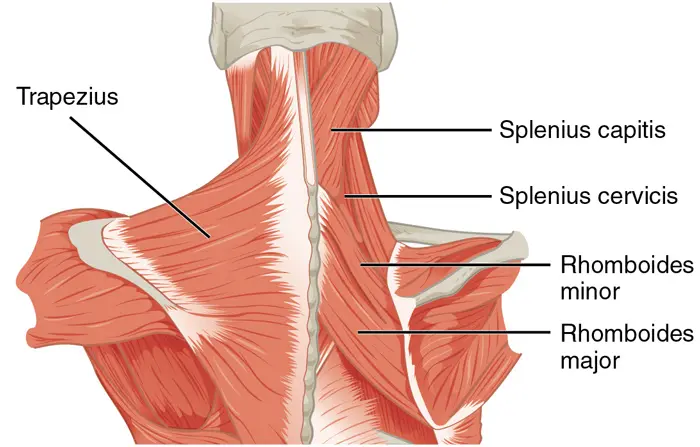
- Upper Traps: These are the muscles you see peeking out of your T-shirt. They connect your neck and shoulder girdle and help elevate your shoulders and tilt your head back.
- Middle Traps: They sit in the middle of your back and help retract your shoulder blades, pulling them closer together. Training these add thickness and width to your back.
- Lower Traps: These reside in the lower part of your back and play a role in depressing the shoulder blades and providing stability. Strong lower traps can improve posture and prevent injuries.
Sample Trap Workout Routine
Traps are a relatively small muscle group. You don’t need to do more than two trapezius exercises in a workout to promote adaptations. Also, intermediate and advanced lifters should limit themselves to two shoulder workouts per week.
“The maximum recoverable volume (MRV) for traps is 12-20 sets per week, but the good news is that the traps recover quickly,” said Dr. Mike Israetel (Ph.D. in Sports Physiology)
With that out of the way, here are the trap-dominant shoulder routines for maximizing hypertrophy:

Beginner Trap Routine
| Exercise | Sets | Reps | % of 1RM |
| Barbell Shrugs | 3 | 8-12 | 60-80% |
| Face Pulls | 3 | 15-20 | >60% |
Intermediate Trap Routine
| Exercise | Sets | Reps | % of 1RM |
| Upright Rows | 3 | 8-12 | 60-80% |
| Scapular Pull-Ups | 3 | 15-20 | (Bodyweight) |
Advanced Trap Routine
| Exercise | Sets | Reps | % of 1RM |
| Overhead Barbell Carry | 3 | 50 feet | 30-50% |
| Rack Pulls | 3 | 1-5 | 80-100% |
Conclusion
These 10 amazing exercises are all you need to develop massive traps. Switching between these movements every few weeks is ideal for hitting the traps from different angles and achieving an optimum growth stimulus.
Whether you’re using free weights, cables, or machines, you can maximize hypertrophy by prioritizing form over heavy lifting. The next time you are in the gym, perform the first workout listed in this article to kickstart your shoulder transformation.
References
- Ekstrom, R. A., Donatelli, R. A., & Soderberg, G. L. (2003). Surface electromyographic analysis of exercises for the trapezius and serratus anterior muscles. The Journal of orthopaedic and sports physical therapy, 33(5), 247–258. https://doi.org/10.2519/jospt.2003.33.5.247


